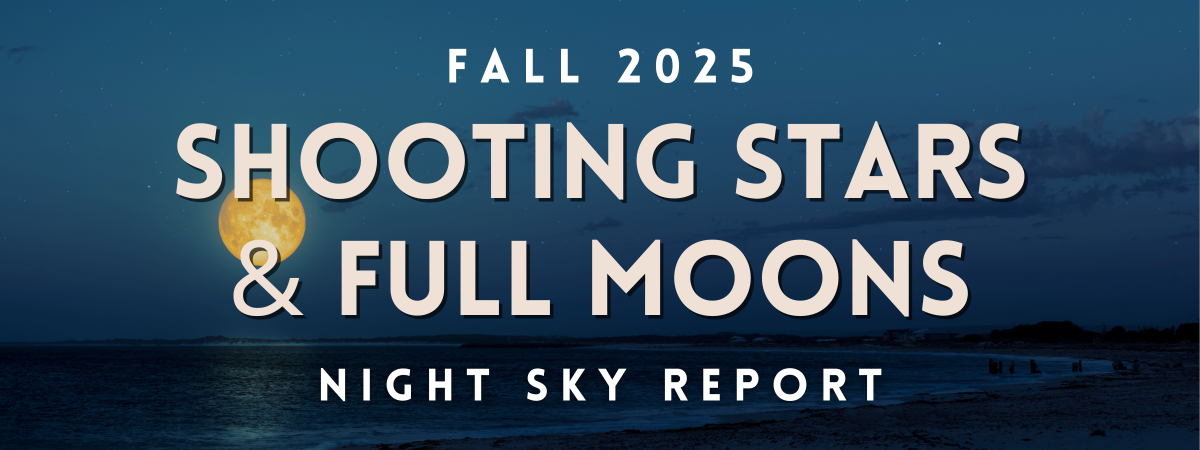Everyone always gushes about Hilton Head Island’s natural beauty—and we don’t disagree, they have a reason to gush! There’s a very noticeable lack of neon signs, billboards, and really anything that’s designed to stick out, for that matter. Throughout your day, you’ll only see greenery, beautiful beaches, and architectural styles that blend in with the landscape on purpose.
But at night, that’s when the feeling-like-you’re-in-the-middle-of-nowhere bliss sets in. Maybe it’s the main reason the trip was booked!
It takes a while to get used to driving at night, as there are very few street lamps to guide your way and it’s just plain dark. That darkness, though, makes Hilton Head an incredible place to look up. With little light pollution across much of the island, the night sky comes alive, especially in October to celebrate World Space Week. Whether you’re stargazing from the beach or your villa balcony, you’ll get a clear view of constellations shifting with the season and perhaps even catch a glimpse of a planet or two shining bright above the coastline.
Here is a list of what to look out for:

Harvest Moon
October 6th
October’s full moon, commonly called the Harvest Moon, is actually 2025’s first supermoon. Supermoons are full moons that are close to, or are at the closest point to Earth in orbit. The best time to see the Harvest Moon in its full glory will be just before midnight at 11:48pm ET. The Harvest Supermoon will be the first out of three that finished off this year.
Draconid Meteor Shower
October 6th-10th; Peak: 8th-9th
The Draconids are set to make their appearance once again this fall, peaking in the late evening of October 8th and into the early hours of the 9th. Those who love keeping an eye on the night sky will know that this meteor shower has a tendency to pop in the evening hours most of all–just try covering the moon as you search the sky. Will this be when the Dragon of the Draconids awakes, meaning hundreds of meteors will pass in an hour? There’s always a chance, so make sure to watch out for it!
Orionid Meteor Shower
October 2nd-November 7th; Peak: October 21st-22nd
How lucky are we to have two meteor showers in one month? If the bright moon detered you from seeing any of the Draconid Meteor Shower, you’ll have much more of a chance to see this one, as the shower’s peak aligns with October’s New Moon (meaning there won’t be any moonlight to cover your view). The Orionids are said to have anywhere from 10 to 20 meteors per hour.
Super Beaver Moon
November 5th
The second supermoon of 2025, early November will welcome the Super Beaver Moon. Why name it after a beaver? Beavers tend to build their dams for winter around this time of the year, and since they’re nocturnal, they’ll be glad for a little extra moonlight on the 5th. Other names for this moon are the Frost Moon, Snow Moon, and Freezing Moon–we’re sensing a trend here.
Leonid Meteor Shower
November 6th-30th; Peak: November 17th-18th
November’s meteor shower stems from the constellation, Leo, and is an annual occurrence that’s beautiful to watch. Find a dark place to watch the night sky and prepare to be dazzled by up to 15 shooting stars per hour!
Super Cold Moon
December 4th
While it’s not a weather prediction, December’s Super Cold Moon will be the third consecutive and final supermoon in 2025. At least, we hope it won’t be super cold on Hilton Head Island that night–there’s things to do and festive lights to see!
Geminid Meteor Shower
November 19th-December 24th; Peak: December 13th-14th
Peaking around December 13–14, this is often the brightest and most reliable meteor display of the year with as many as 50 to 100 meteors per hour under ideal conditions. The Geminids are known for their slow, colorful streaks that seem to radiate from the constellation Gemini, visible high above the Atlantic after 9 p.m.
Ursid Meteors
December 21st-22nd
Just days after the Geminids fade, the Ursid meteor shower offers a quieter encore around December 21–22, coinciding with the winter solstice. Though smaller in number—usually about 5 to 10 meteors per hour—the Ursids can produce unexpectedly bright streaks.
We found a really neat and useful tool for those wishing they could easily point out constellations. Visit Stelvision’s Sky Map and find a free customized map for your location, date, and time!
